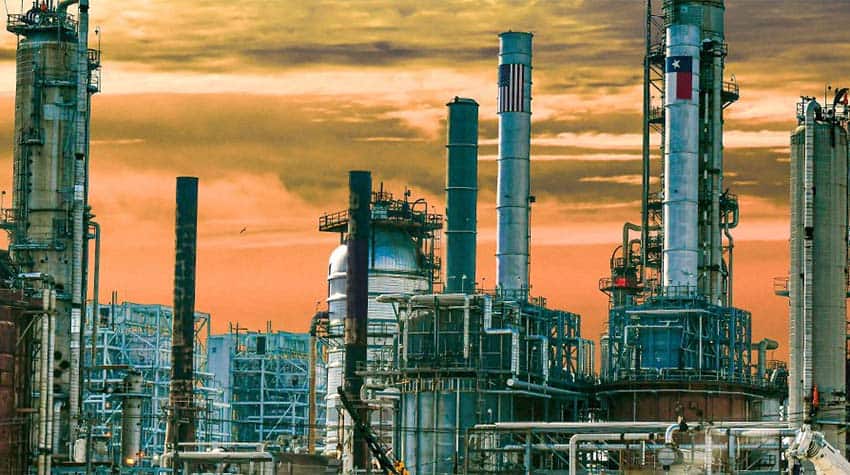Mexico is currently heavily dependent on foreign fuel, but it will stop importing gasoline in the not too distant future, Pemex CEO Octavio Romero asserted Thursday, although projections he presented showed that Mexican production won’t meet demand in the coming years and that the soonest self-sufficiency can be achieved is 2027.
“All the oil we produce will be refined [in Mexico] and there won’t be the need to buy gasoline abroad at the end of this administration and the beginning of the next one,” Romero said at President Andrés Manuel López Obrador’s morning press conference.

López Obrador’s term as president will end Oct. 1, four months after the June 2 presidential election.
During the president’s press conference, Romero presented data that showed that Mexico will in fact still have to import fuel in 2025 and 2026, albeit in significantly lower quantities than current levels. Mexican production shortfalls of 39,000 bpd and 3,000 bpd are projected for 2025 and 2026, respectively.
“Gasoline production levels will go above 1.3 million barrels [per day] starting in 2025 to practically reach self-sufficiency in gasoline,” the Pemex CEO said.
Romero made a strikingly similar remark with regard to 2026, acknowledging that Mexican production still won’t meet demand based on current projections.
In 2026, Mexico will have “practically” no deficit (and thus almost no need to import gasoline) if the increase in demand occurs as expected, he said.
Based on the data Romero presented, the first year in which Mexico might actually reach complete self-sufficiency for gasoline is 2027.
The path to self-sufficiency
Romero presented data that showed that Pemex was producing 300,000 bpd of gasoline, diesel and jet fuel at its six refineries in November 2018, the month before López Obrador took office.

The deficit — i.e. the amount of fuel that needs to be imported — was more than three times higher at 956,000 bpd.
Fuel production at the six refineries — located in Oaxaca, Hidalgo, Guanajuato, Veracruz, Nuevo León and Tamaulipas — was 423,00 bpd last year, a 41% increase compared to November 2018.
Pemex’s total production last year was 655,000 bpd as 232,000 bpd were produced at the Deer Park Refinery in Texas, which the state oil company purchased in 2021.
The fuel deficit in 2023 was slightly lower than production at 625,000 bpd, according to the data presented by Romero.
Pemex is predicting that Mexico’s fuel production will reach 1.232 million bpd in September — López Obrador’s final month in office – leaving a deficit of 62,000 bpd.
Such a level would represent an 88% increase compared to production levels across 2023.

There are two main reasons for the significant increase Pemex is expecting.
Firstly, the recently-built Olmeca Refinery on the Tabasco coast is projected to be producing 274,000 bpd of fuel in September, while output from the other six refineries is expected to be 650,000 bpd thanks to upgrades that will be completed this year.
An additional 66,000 bpd of gasoline and other fuel is slated to come from a new coking plant in Tula, Hidalgo, Romero said.
Fuel production at Pemex’s seven refineries and the Tula coking plant is projected to rise in 2025 and remain steady in 2026. A new coking plant in Salina Cruz, Oaxaca, will provide an additional 37,000 bpd of fuel in 2025 and double that amount in 2026, allowing Mexico to further reduce its reliance on foreign fuel.
As mentioned earlier, the projected fuel deficit is 39,000 bpd in 2025 and 3,000 bpd in 2026.
The key to greater fuel production? More processing
Romero said that Pemex was processing 519,000 bpd of crude at its six refineries when the current government took office in late 2018. At the same six refineries last year 794,000 bpd of crude was refined, he said, a 53% increase compared to the start of López Obrador’s term.
According to data presented by Romero, an additional 270,000 bpd were processed last year at the Deer Park Refinery, lifting the state oil company’s refining total to 1.064 million bpd in 2023.
The Pemex chief said that the Olmeca Refinery — which was inaugurated in 2022 even though the facility was incomplete and not processing oil — will refine 243,000 bpd starting Jan. 31.

“What are we thinking for 2024? To reach 1.512 million [bpd]. Why? Because the six refineries are going to go through the rehabilitation we’re doing,” Romero said, adding that the projection is that they will collectively refine 1 million bpd this year.
If Pemex succeeds in increasing crude processing to 1.512 million bpd this year, it will have lifted its refining total by 191% over the prevailing level when López Obrador was sworn in as president on Dec. 1, 2018.
Reaching self-sufficiency for fuel is a highly sought-after goal of López Obrador, but — despite the gains in crude processing and fuel production — it is not one that will be achieved during his presidency, according to the data presented by Romero.
Mexico News Daily
